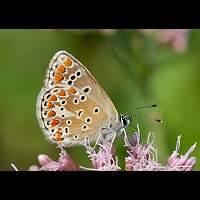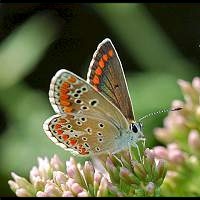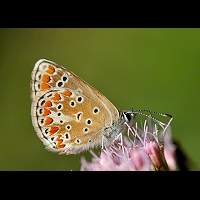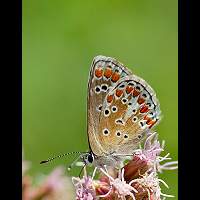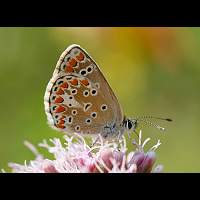Brown Argus Aricia agestis
So far we have seen the Brown Argus only during a two week-period in the extremely hot summer of 2006. Even though Argus species are blue usually, there is not one single trace of blue in the Brown Argus. The female of the Common Blue is very similar. It isn't very complicated to tell the two species apart. One of the main differences is in the orange spots in the upper wing. In the Brown Argus these are big and visible all over the wing, from edge to edge. In the female Common Blue only the dots at the lower edge of the wing are clearly visible. Going to the upper edge the orange dots get smaller and the last two or three are invisible. This is true for both sides of the upperwing. Another difference is that at the base of the wing there is some blue visible in the Common Blue. There is no blue at all in the Brown Argus. The wingspan is some 2.5cm.
The females of the second generation lay their eggs in August mainly. After hatching the small larvae feed by eating the underside of leaves, leaving the upperside intact (windows). Later they'll eat the entire leaf. The halfgrown caterpillars overwinter between plant debris on the ground. In spring they will complete their cycle. From April onwards the larvae will pupate. They need only some 3 to 4 weeks to give birth to new butterflies. The caterpillars secrete a sweet substance, much loved by ants. The ants in return protect the caterpillar from many small predators. This situation is much like the one between ants and aphids. The larva is green with an indistinct pinkish or purple dorsal line. The foodplants are low growing plants, such as stork's bill and rock rose. The caterpillar will reach a length of some 10 to 13mm only.
The Brown Argus has two generations yearly. The first and smallest is on the wing in May and the first half of June. The second generation is on the wing from July to the end of August. Quite a common species in Southern England, where it may be found on open ground, usually with sandy soils. Also present in most of Wales, but here it is a coastal species only. Not found in Scotland and Ireland. On the continent quite common along the entire European coast and seen regularly along rivers.
So far we have seen the Brown Argus only during a two week-period in the extremely hot summer of 2006. Even though Argus species are blue usually, there is not one single trace of blue in the Brown Argus. The female of the Common Blue is very similar. It isn't very complicated to tell the two species apart. One of the main differences is in the orange spots in the upper wing. In the Brown Argus these are big and visible all over the wing, from edge to edge. In the female Common Blue only the dots at the lower edge of the wing are clearly visible. Going to the upper edge the orange dots get smaller and the last two or three are invisible. This is true for both sides of the upperwing. Another difference is that at the base of the wing there is some blue visible in the Common Blue. There is no blue at all in the Brown Argus. The wingspan is some 2.5cm.
The females of the second generation lay their eggs in August mainly. After hatching the small larvae feed by eating the underside of leaves, leaving the upperside intact (windows). Later they'll eat the entire leaf. The halfgrown caterpillars overwinter between plant debris on the ground. In spring they will complete their cycle. From April onwards the larvae will pupate. They need only some 3 to 4 weeks to give birth to new butterflies. The caterpillars secrete a sweet substance, much loved by ants. The ants in return protect the caterpillar from many small predators. This situation is much like the one between ants and aphids. The larva is green with an indistinct pinkish or purple dorsal line. The foodplants are low growing plants, such as stork's bill and rock rose. The caterpillar will reach a length of some 10 to 13mm only.
The Brown Argus has two generations yearly. The first and smallest is on the wing in May and the first half of June. The second generation is on the wing from July to the end of August. Quite a common species in Southern England, where it may be found on open ground, usually with sandy soils. Also present in most of Wales, but here it is a coastal species only. Not found in Scotland and Ireland. On the continent quite common along the entire European coast and seen regularly along rivers.

